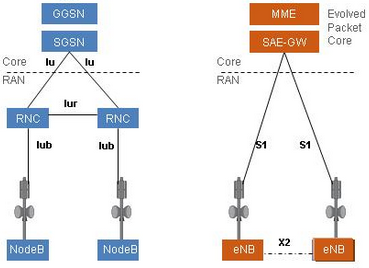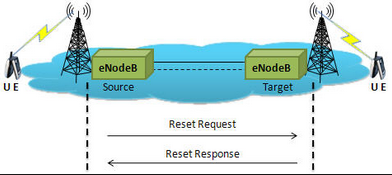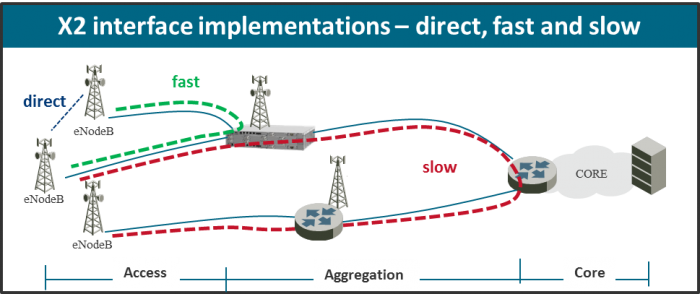What is X2 ?
In all cellular networks, base stations cooperate to provide certain services to subscribers. Think about handover. As you ride in your car talking on your mobile phone (as a passenger, of course), you will eventually pass out of the coverage of your current base station. In order not to lose the call, your base station will cooperate with the rest of the cellular network to automatically find the next base station that can pick up your conversation. This handover from base station to base station is performed so seamlessly that you don’t even notice.

In 2G and 3G networks, handover often requires the involvement of the network core. In the 2G case, when handover is between base stations that are not under the same BSC, the core gets involved. In the 3G case (pictured above-left), RNCs can handle the handover, but when they do not interface with each other, the handover will be processed at the core.
In LTE, the handover intelligence does not necessarily reside in the core. LTE’s intelligent eNodeBs (base stations, in LTE parlance) can execute handovers themselves without the core’s direct involvement. This method is far more efficient and subscriber-friendly as it reduces the considerable network traffic flow from the base stations to the core and the consequential latency. With X2 protocol running between eNodeBs themselves (picture above-right), handover takes less time and requires less network traffic.
The benefits of the X2 interface are not limited to handovers. With the distributed intelligence and X2 communications between them, eNodeBs, can perform load management between themselves (“Hey, I am suddenly busy. Here, you take over this function for me, okay?”). They can report statuses and errors, and perform other cooperative functions as well.

Network Topology Effects
With X2 traffic running between eNodeBs, the network topology changes. Traditional (2G and 3G) cellular networks are built in a kind of hierarchy or tree. Base stations are the leaves while the backhaul network, leading to aggregation points, represents the twigs. Aggregation points are the places where the twigs connect to larger twigs and eventually to the limbs. These limbs eventually combine and connect up to the trunk, the backbone,that leads to the roots, the core network. Information for decision-making flows from the leaves to the trunk where the decisions are made, and commands for execution flow back the other way.
That’s an awful lot of network traffic and time, isn’t it?
In the LTE world, this end-to-end flow gives way to a flatter network where more of the intelligence is distributed around the network so that decisions—like our handover example—can take place way up at the level of the leaves. In this way, traffic that used to flow end-to-end now engages only the eNodeBs who, in many cases, can make their own decisions locally.
In order for X2 to work in all of its glory, eNodeBs must have the means to communicate with each other. As additional LTE advantages require X2 to be as fast as possible (check out ICIC and CoMP for two such examples), implementing X2 with as little latency as possible is mandatory.
There are three methods for implementing X2. In the direct method, eNodeBs can be connected via fiber or wireless in E/V-band or licensed-band. The direct method is the best since it is the most direct and subject to the least latency. Due to expense, distance and other reasons, however, many network operators have so far shied away from implementing such direct links between eNodeBs.

There are two other ways to implement X2. In a “fast” X2 implementation, eNodeBs communicate with each other via their BSC or RNC which acts as a router for this purpose. This cuts deployment cost considerably, but introduces more latency in the arrangement.
In a “slow” implementation, the X2 messaging can travel all the way back to an aggregation point or even the core. Slow X2 implementation is relatively straightforward since this is similar to the way it works in 3G networks. However, as its name indicates, the “slow” implementation is fraught with the highest latency.
HetNet Opportunities:
With the distribution of intelligence in their networks all the way to the endpoints (leaves) and a method for the endpoints to communicate and make decisions between themselves, operators can consider many new sorts of deployments. Suddenly, efficient small cell deployments are possible. Think about a macro base station (eNodeB) on the roof of a building with lots of small cells under its control deployed at the street level below every 50-100 meters. Subscribers can walk down the street, smartphones in hand, with uninterrupted coverage while their calls and Internet sessions continue, bouncing, in a very coordinated way, among the small cells and between the small cells and the base station.
X2 is the eNodeB communication protocol for all of that to occur.
